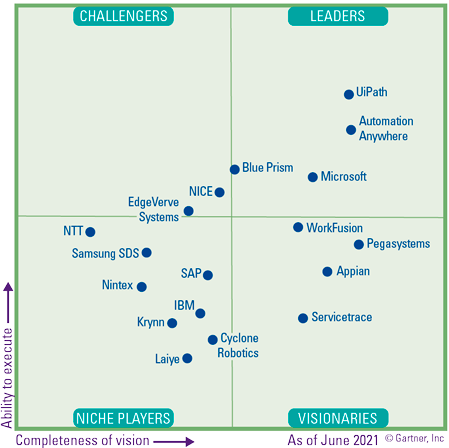RPA tools are becoming increasingly important in the world of automation. They offer a low cost but high value solution for improving efficiency and employee satisfaction. This article describes the landscape of various tools offered by different vendors, and dives into the pitfalls and use cases of the next generation robots. What is the vision of the most important challenger currently on the market: Microsoft? And how can your organization benefit from the use of RPA? In this brief article, we give our opinion on the current market and help you to make the best choices for the future.
Introduction
How many hours per day do you spend on tedious tasks? Monotone tasks like going through your mailbox, seeking the right information to delegate tasks, or doing mundane administrational tasks? Research indicates ([Belo22]) that the average employee spends about 20% of their time on going through their inbox. Another 20% is spent on seeking, copying or validating data and information – think of the list of approvals which some managers have to go through.
If you realize that at least one third of the average daily activities can be automated, think of the impact that would have on one’s personal work life. Wasted time could be regained by automation, allowing you to work on the real important stuff. Automating approval requests, eliminating human error of manual data entry, or reducing wasted time on requesting status updates – these are just a glimpse of the potential tasks which could be easily automated ([Belo22]).
If you grasp the potential of automation on a personal level, just try to imagine what this could do on department, or even company level. UiPath, a leading brand in RPA technologies, surveyed ([Like19]) that on average, departments lose 6 hours per week or more on tasks that could be automated. Imagine the possibilities this offers; freeing up almost a full workday every week to focus on more innovative and creative work.
The potential power of RPA (Robotic Process Automation, a digital robot which can automate tasks), has not been left unattended. Gartner has indicated that 60 percent of the organizations with a revenue of over $1 billion, will have deployed RPA tools before the end of 2022 ([Shet18]). A survey among CIOs, executed by Forrester, also shows that 85% of them expects to adopt RPA in the next few years ([Clai17]).
So, the relevance and impact of RPA is clear: extreme automation can set off a revolutionary change in the efficiency of our work. But what can this mean for your life, and your business? How can your organization profit from the benefits RPA offers, and how can you ensure your mundane tasks are automated?
An RPA robot: the digital twin you’ve never had
Imagine you are working at your desk, and suddenly another person sits next to you. They look exactly like you and will happily ask you to delegate your boring tasks. Imagine now this person is completely virtual and resides within your computer. This person has now become your digital twin, and this is exactly what an RPA robot looks like.
One of the main purposes of this RPA robot is to reduce your repetitive and simple tasks, such as capturing data, to relieve employees from time consuming and little value-added activities. This way, you can allocate your time better, and focus on the potential of their work. This is usually done by mirroring a user’s activity in their management systems. Modern RPA tools combine this with smart cloud-based solutions to leverage the power of the cloud such as AI and Machine Learning.
Not only does this save time and improve employee happiness, the automated tasks are also executed more efficiently, as described below in the advantages of RPA:
- Accuracy is increased by eliminating human error rate, reducing manual journal entries and more consistency in the processes.
- Efficiency is improved by reducing the process cycle time and continuous task performance. A robot is never tired, nor does it ever need to take a pause or go to sleep.
- Process improvement is enhanced by increased visibility and transparency, standardized processes and higher transaction capacity.
- Governance, control & compliance is performed better by eliminating fraudulent activities, continuous controlling and policy updates.
- Quality is increased by detecting bad data quality, monitoring the system performance and enabling regular system checks.
- Costs are decreased by having an enhanced and standardized IT system, less implementation times, process enhancements, and so on.
The RPA market is booming, and the software landscape consists of several vendors, including UiPath, BluePrism, Automation Anywhere and Appian. Since December 2020, Microsoft launched Power Automate. This is Microsoft’s answer to RPA. Below you will find some examples about the most interesting RPA cases that we implemented for our clients.
RPA business case 1
One of our customers has over 180 legal entities operating in more than 70 countries with local often on-premises ERP-Systems. Using Power Automate, we were able to quickly deploy robots in the cloud and in the same Azure region as the entity, to cope with latency. A central RPA team now manages these robots to manage the accounts payable process. The robots read e-mails from the local accounts-payable@customer.com e-mail box. Subtract the invoices in PDF and sends them to the Azure Cognitive Services for capturing the invoice details. These details are then sent, by the RPA robot, to the ERP-system for processing of the invoice headers and lines. This way we realize about 96% immediate processing of the invoices.
RPA business case 2
Another example is where we build an RPA robot to assist onboarding of new employees. Employee detailed information often needs to be represented in various systems such as the ERP-system, time management system, planning system, procurement system, the company phonebook etcetera. The RPA team built a robot to capture information from every new hire from the HR system and copy all this information in the various systems where employee information is required. This way the information is always accurate, and input is done on or before the first day of work without manual intervention.
These are examples of how RPA has helped many organizations. From now on, it is the robot that does all the tedious work. The robot does not need a coffee break, have lunch, dinner or go to sleep. The supporting functions now free up their time to spend on more relevant value adding activities, while all the work is done by the robot. The organisation simply has to manage this new “employee”, by regularly checking its output, and make sure it has enough input (no coffee …). This then really finishes the saying: “it’s a dirty job, but someone has to do it – well, the robot!”
A new player who brings new opportunities
Like in any market, a new player brings new possibilities. Although the RPA landscape looked saturated, Microsoft has found a unique way to shake up this traditional approach and introduced a drastically new view to RPA development. Where before you might have needed a full team of several programmers to create your digital twin robot, imagine how you can now instruct your bot completely by yourself, with a level of ease that will blow your mind.
Microsoft calls this the citizen programmer and has dedicated their full focus to it. This is not the die-hard technical programmer but could be just anyone like you or me. To rapidly create solutions, making use of the latest technology, low-code platforms have been developed for these “citizen developers”. Microsoft has launched its Power Platform to accommodate for this need. The Power Platform consists of four main parts: Power Automate, Power BI, Power Apps, and Power Virtual Agents, and is constantly being updated to make use of the latest available technology. This way it is quite easy to make effective solutions, which make use of innovative technology. For example, you can develop a chatbot in a couple of hours, or, and that is where the interesting part comes in: make a robot to outsource your daily mundane tasks, in just one afternoon of programming. Well, if that is not well-invested time?
RPA for Power Automate has generally become available late 2020 when Microsoft acquired Softomotive. Hereby increasing Power Automate capabilities such as enhanced low-code desktop automation with WinAutomation, a robust set of “Out of The Box” UI automation drivers and, parallel execution and multitasking ([Ghos21]). Power Automate is now one of the key components of the Power Platform. Below are some of the examples that Power Automate can be used for ([Fern22]):
- Automate business processes
- Send automatic reminders for past due tasks
- Move business data between systems on a schedule
- Connect to more than 500 data sources or any publicly available API
- You can even automate tasks on your local computer like computing data in Excel.
Power Automate consists of six different types of flows: automated cloud flow, instant cloud flow, scheduled cloud flow, business process flow, process advisor, and desktop flow. All these flows meet various business needs. Whereas cloud flows are event-driven flows, business process flows can be considered as user guides. On the other hand, process advisor, as a new component of Power Automate, can be used to optimize your existing processes and tasks with task mining and process mining capabilities. Last but not least, Power Automate desktop flow helps to automate processes as Microsoft’s robotic process automation tool for on premise applications.
Process advisor was recently added to the Power Automate suite. It allows you to discover inefficiencies across your organization by connecting, transforming, and uploading data from a wide variety of sources and by visualizing a process map to gain insights from the data.
Task mining helps to record all executed tasks. Based on this data, the tool provided guidance to help citizen developers to automate their daily routines.
Finally, AI builder has been added to Power Automate. You will soon need a data scientist to build AI models for you. AI builder comes with several pre-build data models that can be trained and used to assist in various use cases. Expect more usable standard AI-models to be published. Currently, Microsoft already has standard AI models such as for photo recognition, unstructured document analysis, customer sentiment recognition and prediction of business outcomes.
As shown Figure 1, which was introduced in the Gartner RPA article ([Vill21]), within a year, Microsoft has become a leader in the Magic Quadrant with its RPA product: Power Automate. Microsoft benefits from SaaS-based automation platform on Azure to enhance the desktop version of Power Automate, making it much more scalable and robust. There is an easy interface and it uses the complete stack of Azure services and functions such as smart OCR, AI, Machine Learning, and many others. It also easily connects to Microsoft 365, Dynamics 365, Data Verse and many other Microsoft data services.
Figure 1. Magic Quadrant for Robotic Process Automation ([Vill21]). [Click on the image for a larger image]
Conclusion
RPA is booming and will only grow further in the future. The possibilities are infinite, but in general always come back to a great ease of outsourcing mundane tasks to a robot. The impact of this potential is yet to be uncovered but looks promising. In combination with the limited effort development of such solutions requires, and the possibility of programming one as a “regular user” – or: citizen developer – this will increase the impact of RPA.
This development is also discovered by vendors: Gartner shows an already saturated, but highly changing market, in which the future should distill the true market leaders. Highlighted in this article is the solution from Microsoft, not only interesting because of the rapid growth, but more so of the underlying mindset of the tools’ functionalities. This is not just aimed at skilled developers, but increasingly at ordinary citizen developers. Therefore, the Microsoft product stack proves to be highly interesting. Altogether it proves that RPA should not be ignored, so that it can truly grow into the “digital twin you’ve never had.”
An Automation Platform can bridge the gap between business requirements and standard company systems. The platform has different components which support diverse needs of the business functions. As can be seen from the case studies, the organizations add great values to their business processes by combining RPA with their business processes.
Important aspects to look for when selecting any automation system are:
- Value case. What value does automation need to bring to the business. This value case should then drive the decision-making process during the implementation phase but can already help during selection.
- Purpose. Some tools are more focused on text recognition, some are more focused on on-premise, legacy systems or come from a specific sector, like financial services. It is advisable to look for a specific functionality that fits the main purpose of you automation.
- Infrastructure. Most RPA tools come from a legacy on-premise background. All of them are working towards deployment in the cloud. Having a good idea of how the RPA tool will be deployed in your infrastructure considering you primary use cases is vital. Challenges can be security, identity management, latency, connectivity, the types of databases that can be supported, disaster recovery procedures and compatibility with implemented network security measures such as firewalls, multi factor authentication, anti-virus etcetera. Being an integral part of the Microsoft eco-system, Power Automate is very well integrated into the Azure infrastructure.
- Interoperability. All or most RPA tools can work with APIs. But building custom APIs can be a lot of work and requires specific maintenance. All of them come with standard connectors as well. Finding an RPA tool that has the connectors you need can save a lot of time during implementation and during the whole lifecycle of the product.
- Availability of pre-built robots. Ready to use robots are available for a wide range of applications. These can be used as an accelerator to implement your organization’s specific use cases. Robot market places, pre-configured AI models, ready to use flows that would fit you software environment and your use cases can accelerate adoption considerably.
References
[Belo22] Beloof, K. (2022). How Much Time Are You Wasting on Manual, Repetitive Tasks? Smartsheet. Retrieved from: https://www.smartsheet.com/content-center/product-news/automation/workers-waste-quarter-work-week-manual-repetitive-tasks
[Clai17] Le Clair, C., King, M., & Cullen, A. (2017, February 13). The RPA Market Will Reach $2.9 Billion By 2021. Forrester. Retrieved from: https://www.forrester.com/report/The-RPA-Market-Will-Reach-29-Billion-By-2021/RES137229
[Dekk19] Dekker, M., Cherenkova, L., Cligge, M., & van der Meulen, S. (2019). Robotics Process Automation, Address Functional and Technical Challenges during SAP Implementation Projects with RPA. Compact, 2019(1). Retrieved from: https://www.compact.nl/en/articles/robotics-process-automation/
[Fern22] Fernandez, J. et al. (2022, May 17). Get Started with Power Automate. Microsoft. Retrieved from: https://docs.microsoft.com/en-us/power-automate/getting-started
[Ghos21] Ghosh, D. (2021, February 22). Looking Back on Power Automate’s 2020. Microsoft. Retrieved from: https://powerautomate.microsoft.com/en-us/blog/looking-back-on-power-automates-2020/
[Like19] Likens, S., Reese, B., Veloso, M., & Whittaker, M. (2019). The advance of automation: Business hopes, fears and realities. Economist Intelligence Unit. Retrieved from: https://automationfirst.economist.com/wp-content/uploads/2019/06/EIU-UiPath-The-advance-of-automation-briefing-paper.pdf
[Shet18] Shetty, S. (2018, November 13). Gartner Says Worldwide Spending on Robotic Process Automation Software to Reach $680 Million in 2018. Gartner. Retrieved from: https://www.gartner.com/en/newsroom/press-releases/2018-11-13-gartner-says-worldwide-spending-on-robotic-process-automation-software-to-reach-680-million-in-2018
[Vill21] Villa, R. et al. (2021, July 26). Gartner Magic Quadrant for Robotic Process Automation. Gartner. Retrieved from: https://www.gartner.com/en/documents/4004033






